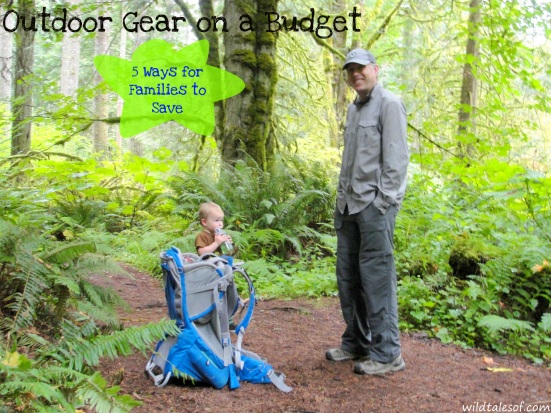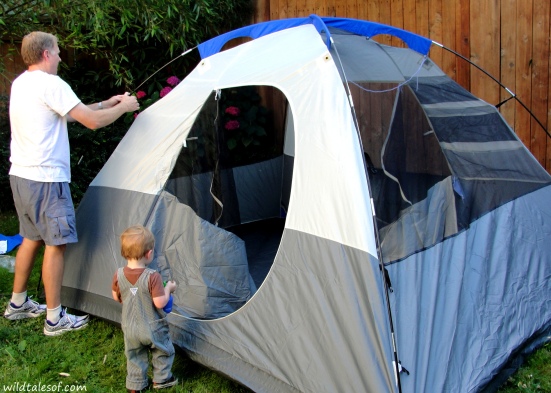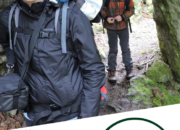Now that we’re really in the thick of summer here in Seattle, I got gear on my mind. I’m especially thinking about all the supplies we need for our adventures with our camping trip to the Olympic Peninsula coming up quickly. We’re not exactly minimalists when it comes to camping, and we also don’t go overboard with supplies, but the essentials for us like a good tent, backpack carrier for Bergen (nearly 2 years old), sleeping bags, and even things like boots and the right clothes are all important for us to be comfortable and have a successful trip.

As we go through mental lists, actual written-on-paper lists, and our basement to prepare, I thought I’d share the ways we acquired all this gear in the first place. Many items, if we want something of quality, come with a hefty price tag, and we’ve found a few ways to work around the steep cost. At the same time there are other items that are not as necessary, but nice to have. We love finding ways to save on those fun or comfort items too.
1. Make a Wish List.
We try to plan and anticipate the big ticket items we might need or want in advance. We keep track of these items, make lists, and then when the opportunity arises, we might tell family and friends. When birthdays, Christmas and other celebrations come around, we are prepared, and can tell people exactly what we have in mind (if they ask!). If the item is too much for even one gift giver to handle, we might even ask for a contribution toward the purchase, or hint toward a group effort.
2. Buy Used.
You know that wish list? It also comes in handy when we are out and about. When shopping, I tend to get overwhelmed and lose focus, but if I have a goal in mind, especially when shopping thrift stores, I’m more successful and don’t make the mistake of overbuying or buy things we don’t really need.
Goodwill, thrift stores, garage & yard sales, craigslist, and our local parent network are all great resources for us to find quality used gear. We’ve even been lucky to find items that people have only used a handful of times, so it’s practically new, but half the cost (or less). It’s at these types of places, where we also purchase things that are more of a fun item, but not completely necessary. The other day, we were at a local children’s consignment store looking for shoes for Bergen. While we didn’t find shoes, we did come across a great camping chair for him! Was it completely necessary? No, but for $5, it’ll be a fun item to have for our trip.
3. Deep Discount Sites.
Sites that hold “flash sales” or a deal-of-the-day can also come in handy when you have gear that you need in mind. Items are offered at deep discounts and if you pay attention and are able to act quickly, you can take advantage There’s some work involved because you have to sift through all that you don’t need or want, but in the name of saving money, it’s worth the effort. For gear, I just discovered a handy resource at http://www.theclymb.com/ . I get an email notification each morning of the daily deals offered, and can quickly decide if there is anything worthwhile for me to purchase. At the moment, I’m on the lookout for hiking gear that Bergen will need as he gets older and is doing more and more actual hiking on his own. Shoes and a backpack fit for a toddler are two things on my mind.
4. Wait for it.
We love hitting sales, and it’s often at the end of the season or just completely off the season that we find the best deals. Sure, it’s not as fun because we might not be able to wear or use the gear right away, but again, it’s a small price to pay for saving money. It’s even helpful for smaller ticket items that can add up. Take shoes for example. I hate paying full price for foot wear that Bergen will only wear for a short time since he grows so fast. This year we snagged a great pair of rain boots that he can wear in the fall, but we bought them in April at an end-of-season sale. This works out well, but we do have to think ahead and take a gamble on predicting sizes.
5. Borrow or Rent.
There are just some items that we know we won’t use frequently enough to warrant a purchase, and we know it would be a waste of money to spend the big bucks. Renting or borrowing really makes sense when we know we’d use the item infrequently and only under certain circumstances. I’d love my own pair of snowshoes, but even though the snow isn’t that far away here in Seattle, I’m better off borrowing them from a friend (or renting) because I know I’d really only use them once a year, or even less.
Just remember to check the gear thoroughly when renting or borrowing. Many, many years ago when I borrowed a tent for a camping trip to Montana, we opened the bag only to find a tarp and poles, but no tent! We ended up scoring a great tent at the thrift store the next day, so it worked out okay, but the first night wasn’t exactly what we expected.
Do you have any money saving tips for purchasing great outdoor gear? Or have you used one of these tricks? Let us know in the comments below.
More on our favorite adventure/outdoor gear:
Come join the conversation! You can keep up to date with each and every post by subscribing to the blog via email. We’d also love to have you join us on all of our adventures by “liking” our facebook page and following us on twitter!

This post is sponsored by The Clymb. All content and opinions are my own.
 How to Get More Creative with Family Camping Meals: Chef Corso’s MONTyBOCA
How to Get More Creative with Family Camping Meals: Chef Corso’s MONTyBOCA Camping with Kids at Washington’s Scenic Beach State Park
Camping with Kids at Washington’s Scenic Beach State Park Healthy Breakfast for Adventure Families: Apple Carrot Squash Muffins
Healthy Breakfast for Adventure Families: Apple Carrot Squash Muffins Outdoor Mom Academy: Take Your Family’s Outdoor Adventures to the Next Level
Outdoor Mom Academy: Take Your Family’s Outdoor Adventures to the Next Level
Go for last year’s colors when buying new.
I’ve had great luck at Desert Industries. It’s a thrift shop out of Utah, they have one on Aurora. Mormons tend to be well-dressed people, I think they retire clothes long before they’re worn out.
Hike and camp with well-supplied friends. Everyone needs their own sleeping bag, but one water purifier is enough for the whole group.
Such great suggestions–Thank you or adding them! I hadn’t heard of Desert Industries..will definitely look into it now. Another one we check out from time to time is Second Assent in Ballard.
Love the tip on coordinating with friend/companions too–very smart. Silly to spend money on gear you might not need yet.